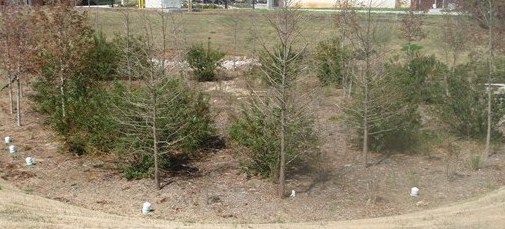Stormwater Management

Stormwater includes rainfall, snow melt, and all other forms of precipitation that flows off of driveways, parking lots, roofs and other hard surfaces into the local drainage system. The drainage system includes storm sewers, ditches, culverts, streams and roadside swales that carry stormwater away from roads and private property.
Maintenance on the drainage system includes work on the storm sewers themselves as well as general upkeep on creeks, streams, ditches, culverts and other components of the drainage system.
Stormwater Management
The Town's stormwater management program addresses increasingly stringent stormwater regulations that were created by the federal Environmental Protection Agency and subsequently adopted by the North Carolina Department of Environmental Quality (NCDEQ). The Town of Wake Forest must meet the stormwater permitting requirements set forth by these entities. It is the Town's goal not only to meet these new permitting requirements, but to also provide current and future residents with a stormwater management program that will protect our drainage infrastructure, improve the efficiency of the overall drainage system, and ultimately enhance the local environment. Infrastructure refers to the physical components of the drainage system, such as pipes, stream banks, and detention ponds.
Did you know that sediment is the number-one pollutant in the country and in North Carolina? This is one of the issues Wake Forest is attempting to address with the stormwater management program to deal with pollutants that are deposited into our drainage system by stormwater runoff. This runoff - then drains either directly to a water body or to a storm infrastructure that flows to a waterbody - and carries with it the pollutants it has picked up. Waterbodies are sources of drinking water and pollutants must be removed before the water is safe to drink. Our program also focuses on protecting our infrastrucure from erosion. Erosion of our pipes, streams, detention basins, culverts and other components of the drainage system ultimately decrease the effectiveness of our drainage system and leads to costly system maintenance issues. The Town of Wake Forest also has their own Erosion and Sediment Control requirements for all proposed development.
All property owners will benefit from the new stormwater management program. The program will lead to improved stormwater quality that travels through our local drainage system. The program will also fund important drainage system improvements. Both of these issues will help increase the efficiency of the Town's stormwater drainage system. It will also help protect and preserve the quality and aesthetics of our local environment.
You Can Help
There are numerous simple steps property owners can take to help prevent erosion of the local drainage system:
Avoid dumping yard waste in or near local waterways. Not only is this action illegal, but it also is very detrimental to the drainage system.
Do not deposit yard waste in the street gutters. Yard waste should be placed behind the curb on the yard side when placed for pick up.
If you live near a stream or body of water, refrain from mowing to the edge of a waterway. Heavier vegetation at the edges of the waterway helps to reduce and filter stormwater runoff that ultimately accelerates erosion.
Call Wake Forest's Stormwater Engineer, Monica Sarna 919-435-9442, to report potential pollution sources, significant erosion, or areas needing stormwater infrastructure maintenance. You can also use See.Fix.Click to report stormwater issues to the Public Works Department.
Stormwater Management Requirements
The US Environmental Protection Agency, as well as the NC Department of Environmental Quality, are both great sources of information on stormwater management requirements.
National Pollutant Discharge Elimination System - Phase II
NPDES stands for National Pollutant Discharge Elimination System, which is a permit program administered by individual states that controls water pollution by regulating point sources (e.g. pipes and man made ditches) that discharge pollutants into public bodies of water. NPDES permitting regulations have become more stringent over the years, thus forcing cities to expand stormwater management programs. The Town of Wake Forest is a 2000 census designee. The US Environmental Protection Agency designated the Town for inclusion in the Phase II stormwater program because its municipal boundary intersects a US Census-defined Urbanized Area.
